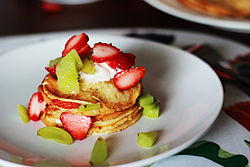Pancake
 Pancake
PancakeA pancake is a flat cake, often thin, and round, prepared from a starch-based batter that may also contain eggs, milk and butter, and cooked on a hot surface such as a griddle or frying pan, often in oil or butter. In Britain, pancakes are often unleavened, and resemble a crêpe. In North America, a raising agent is used (typically baking powder). The American pancake is similar to a Scotch pancake or drop scone. Commercially prepared pancake mixes are produced in some countries.
They may be served at any time with a variety of toppings or fillings including jam, fruit, syrup, chocolate chips, or meat. In America, they are typically considered to be a breakfast food. In Britain and the Commonwealth, they are associated with Shrove Tuesday, commonly known as Pancake Day, when perishable ingredients had to be used up before the fasting period of Lent began.
Archaeological evidence suggests that pancakes are probably the earliest and most widespread cereal food eaten in prehistoric societies. The pancake's shape and structure varies worldwide. A crêpe is a thin Breton pancake cooked on one or both sides in a special pan or crepe maker to achieve a lacelike network of fine bubbles. A well-known variation originating in southeast Europe is palaÄinke, a thin moist pancake fried on both sides and filled with jam, cheese cream, chocolate, or ground walnuts, but many other fillings, both sweet or savoury, can also be used.
The Ancient Greeks made pancakes called τηγανίτης (tēganitēs), ταγηνίτης (tagēnitēs) or ταγηνίας (tagēnias), all words deriving from τάγηνον (tagēnon), "frying pan". The earliest attested references to tagenias are in the works of the 5th-century BC poets Cratinus and Magnes. Tagenites were made with wheat flour, olive oil, honey, and curdled milk, and were served for breakfast. Another kind of pancake was σταιτίτης (staititēs), from σταίτινος (staitinos), "of flour or dough of spelt", derived from σταῖς (stais), "flour of spelt".Athenaeus mentions, in his Deipnosophistae, staititas topped with honey, sesame, and cheese. The Middle English word pancake appears in English in the 15th century.
...
Wikipedia